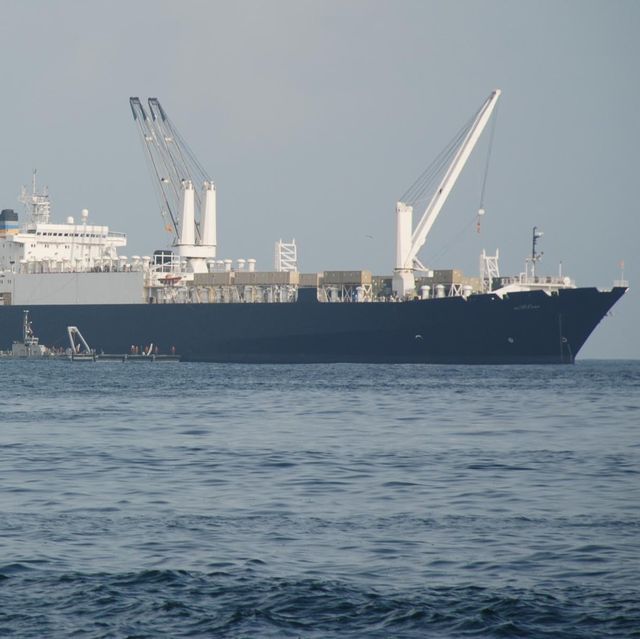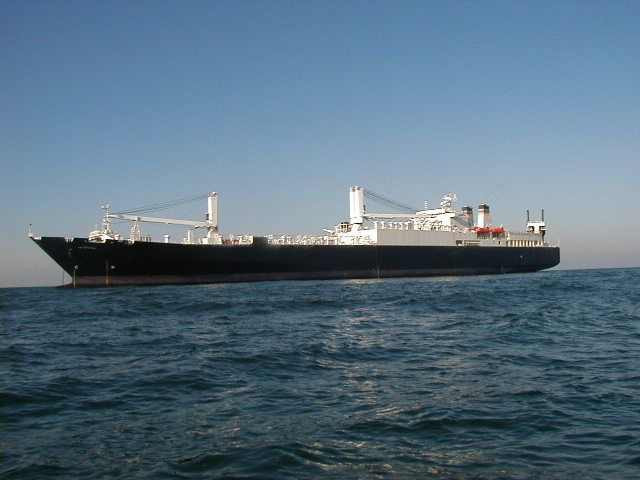- A U.S. Navy cargo ship has the unusual distinction of having been built in the Soviet Union.
- USNS Lance Cpl. Roy M. Wheat was originally built as the Vladimir Vaslyaev.
- The ship now sits in the Mediterranean, packed with supplies for the Marine Corps and Navy.
The U.S. Navy’s Maritime Sealift Command sails a number of odd-looking ships, but just one has the unusual background of having been built in the former Soviet Union. The USNS Lance Cpl. Roy M. Wheat, a cargo ship designed to carry supplies for the Marine Corps, was built in the former soviet republic of Ukraine and bought on the open market by the U.S. Navy. Nearly as large as an aircraft carrier, Wheat and her sister ships sit packed with Marine Corps equipment in the Mediterranean, waiting for the day they are needed.
The Military Sealift Command is a navy within a navy, a fleet of unmanned, non-combat ships staffed by civilians. MSC ships undertake a variety of roles, including refueling and resupplying U.S. Navy warships at sea, oceanographic survey, submarine maintenance, and even supporting missile tests at sea. One of the most unusual MSC ships is the Sea-Based X-Band Radar or the “floating golf ball,” a giant radar designed to detect ballistic missile launches.
The ship with the weirdest pedigree, as Forbes points out, is the USNS Lance Cpl. Roy M. Wheat. The Wheat was built at the Chernomorski naval yard in Nikolayev, the same location Russia’s only aircraft carrier, the Admiral Kuznetsov, was built. Named the Vladimir Vaslyaev, she was operated by the Black Sea Shipping Company until the Soviet Union’s dissolution in late 1991.
The former Soviet states, the main Soviet government having abruptly collapsed, had far more equipment than they needed or could afford to operate. Vaslyaev went on sale in 1997, and the U.S. Navy snapped it up for an undisclosed price. After a refit to bring her up to MSC standards at the Bender Shipbuilding & Repair Co in Alabama, the ship was renamed USNS Lance Cpl. Roy M. Wheat and commissioned into service in 2003.
Wheat displaces 15,804 tons empty, but she can also take on an additional 35,000 tons of equipment and supplies. The ship is 864 feet long, as long as a Wasp-class amphibious assault ship, and has more than 100,000 square feet of floor space. At the time she entered service in 2003, Military Sealift Command stated she would carry, “a (500 bed) Navy fleet hospital, an expeditionary airfield, naval construction battalion equipment, ammunition and other supplies.” Wheat is assigned to Maritime Prepositioning Ship Squadron One and typically is on station in the Mediterranean, prepared to assist Marine Corps operations throughout the region.
Wheat is named after Congressional Medal of Honor recipient Marine Corps Lance Cpl. Roy M. Wheat. Wheat, who served during the Vietnam War, was nominated for the Medal after throwing himself on an anti-personnel mine. Wheat saved the lives of those around him but was killed as a result.
Source: Forbes

Kyle Mizokami is a writer on defense and security issues and has been at Popular Mechanics since 2015. If it involves explosions or projectiles, he's generally in favor of it. Kyle’s articles have appeared at The Daily Beast, U.S. Naval Institute News, The Diplomat, Foreign Policy, Combat Aircraft Monthly, VICE News, and others. He lives in San Francisco.














